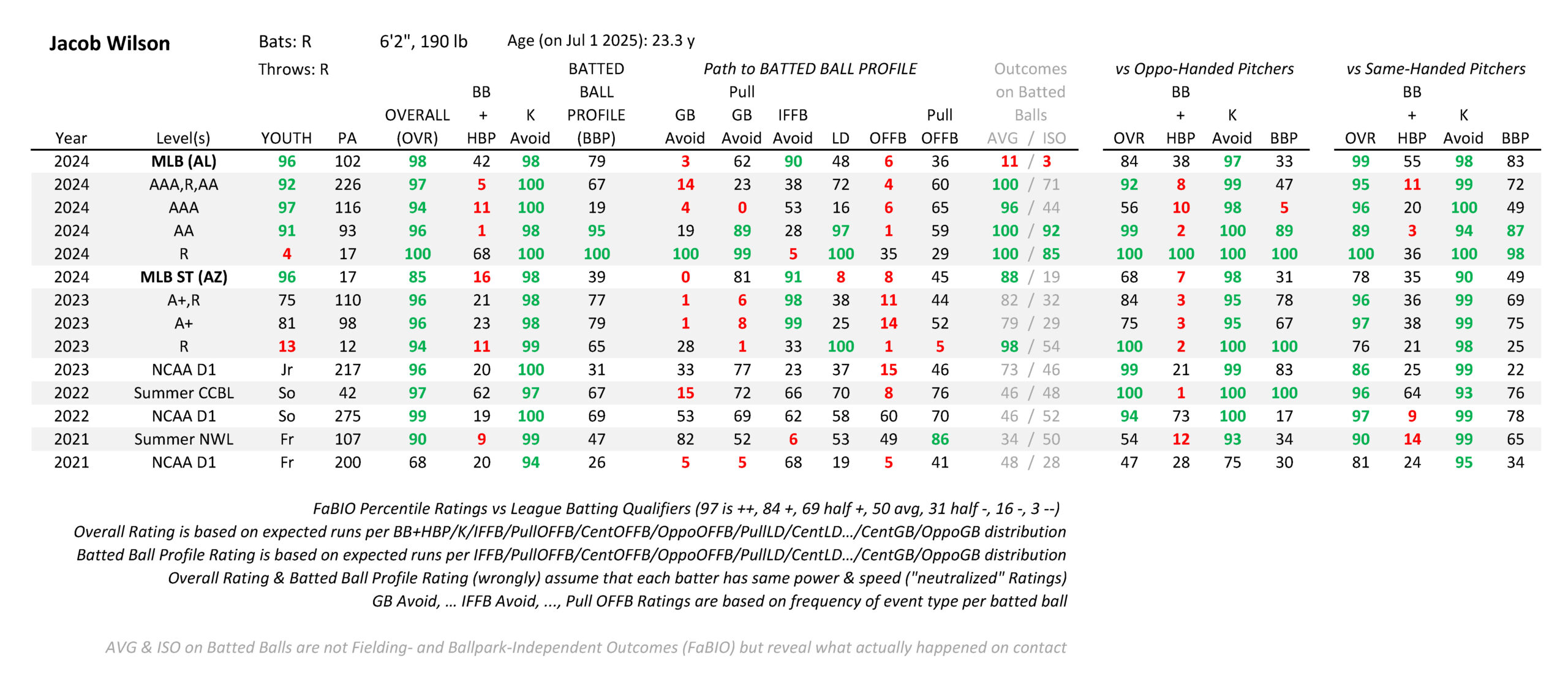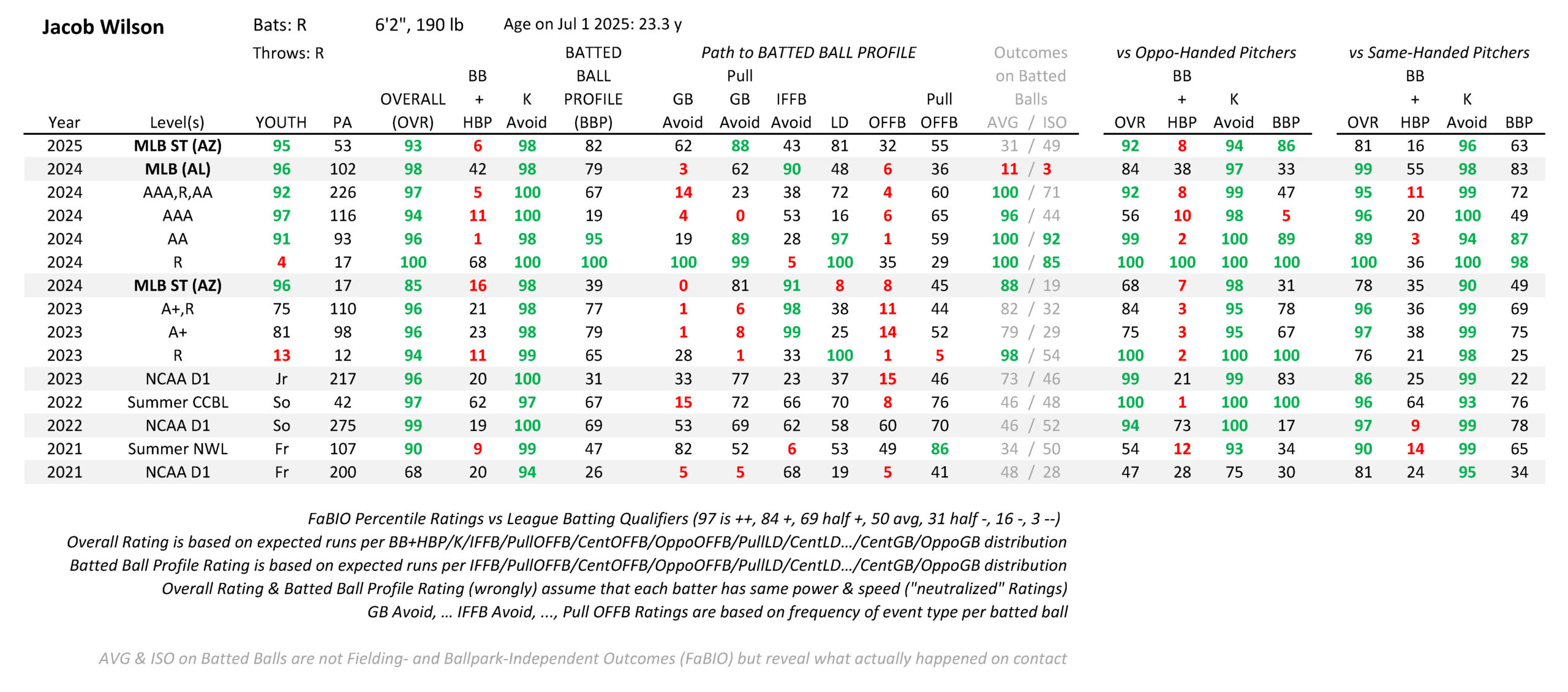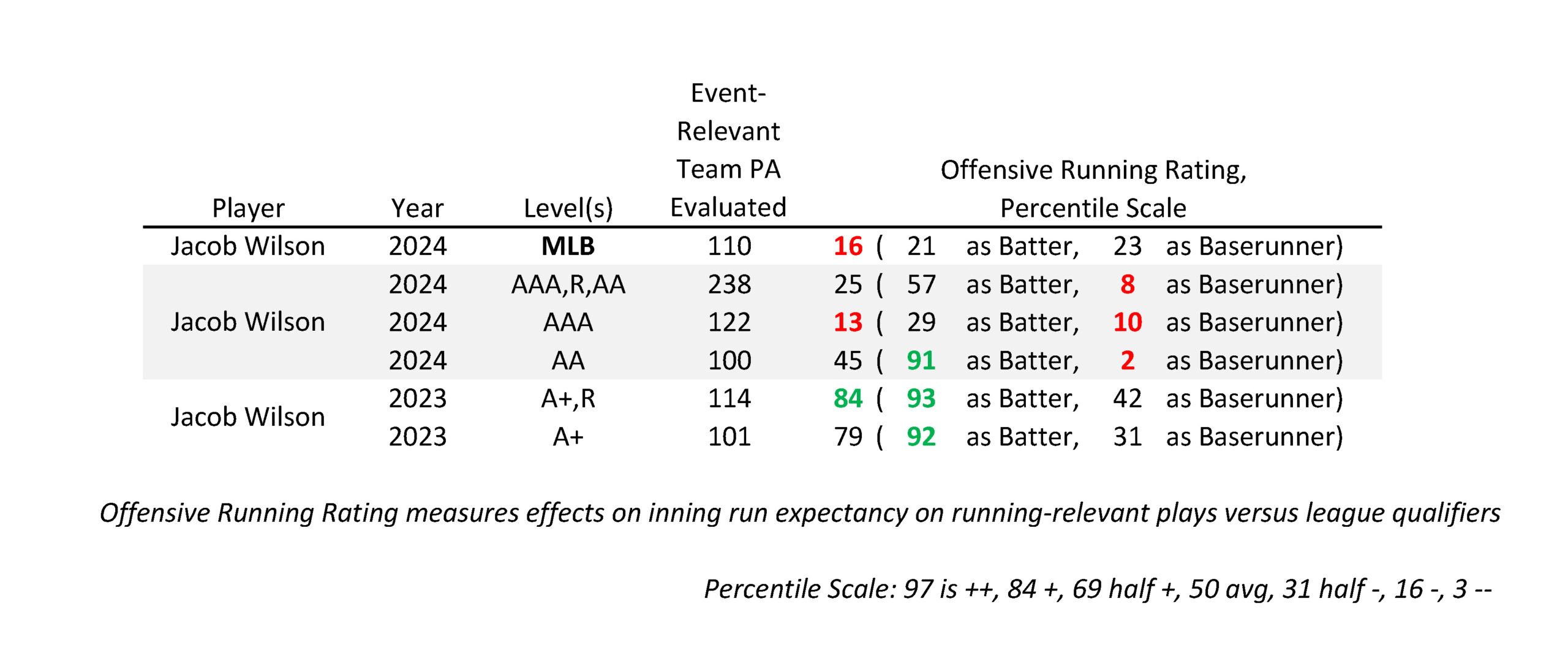Jacob Wilson's fantasy baseball prospect outlook, sleeper potential for dynasty leagues. Matt uses his custom suite of fundamentals-rooted evaluation tools.
To this point in my RotoBaller writing, I have only discussed the application of the FaBIO model to pro and college pitchers.
But in the interim, I have been using a similar model for analyzing college batters, and in the past year, such work has spilled over to the same model for pro batters.
Let us use this tool to examine position player prospects who met rookie eligibility criteria at the start of the 2025 MLB season, starting with Jacob Wilson of the Athletics.
Be sure to check all of our fantasy baseball lineup tools and resources:- Fantasy baseball trade analyzer
- BvP matchups data (Batter vs. Pitcher)
- PvB matchups data (Pitcher vs. Batter)
- Who should I start? Fantasy baseball comparisons
- Daily MLB starting lineups
- Fantasy baseball closer depth charts
- Fantasy Baseball live scoreboard
- Fantasy baseball injury reports
Brief Explanation of the FaBIO Model
My Fielding- and Ballpark-Independent Outcomes (FaBIO) evaluation model sorts every plate appearance into one of 12 outcome bins (BB+HBP, K, IFFB, Pull-Third OFFB, Center-Third OFFB, Oppo-Third OFFB, Pull-Third LD, Center-Third LD, Oppo-Third LD, Pull-Third GB, Center-Third GB, Oppo-Third GB) and charges the pitcher and batter with their league's mean runs value for said particular event that season.
Dividing a batter's total number of expected runs by plate appearance (PA) yields expected runs per PA that can be percentile ranked relative to the league mean and standard deviation for that parameter amongst league batter qualifiers to arrive at their Overall Rating.
Its three subcomponents of BB+HBP Rating (based on BB+HBP per PA), Strikeout Avoid Rating (K Avoid, based on K per PA), and Batted Ball Profile Rating (expected runs per batted ball) are also reported to identify the path the batter traveled to reach their Overall Rating.
Overall Rating and Batted Ball Profile Rating of batters should be considered power- and speed-neutralized metrics since the real-world runs value of a single batter's typical OFFB or LD varies with their strength, and the expected runs value of their typical GB varies with their speed.
To better understand the Path to Batted Ball Profile, we will also examine percentile ratings for select batted ball event types (on a per-batted ball basis). To check how well expected batted ball outcomes matched real-world ones, we will compute percentile ratings for hits (AVG) and isolated power (ISO, or simply extra bases) on batted balls (recognizing full well that these two parameters are neither fielding- nor ballpark-independent outcomes).
What most explains a batter's ability to generate hits (AVG) on batted balls is any LD, IFFB avoidance, Pull-Third OFFB, and Pull-Third GB avoidance. What most explains their ability to generate extra bases (ISO) on batted balls is any OFFB, Pull-Third OFFB, Pull-Third LD, and IFFB avoidance.
A percentile rating of 97 amounts to plus-plus (two standard deviations above the mean), 84 is plus (one standard deviation above the mean), 69 is half plus, 50 is average, 31 is half minus, 16 is minus, and three is minus-minus.
A new addition to this suite of evaluation models is Offensive Running Rating. This tool quantifies how each relevant inning's run expectancy was impacted by the player's action or inaction as either a batter or baserunner on very specific types of plays that are more likely to involve one or both of their speed or offensive running technique, plus acumen.
The evaluated batter and baserunner events are summarized in the graphic.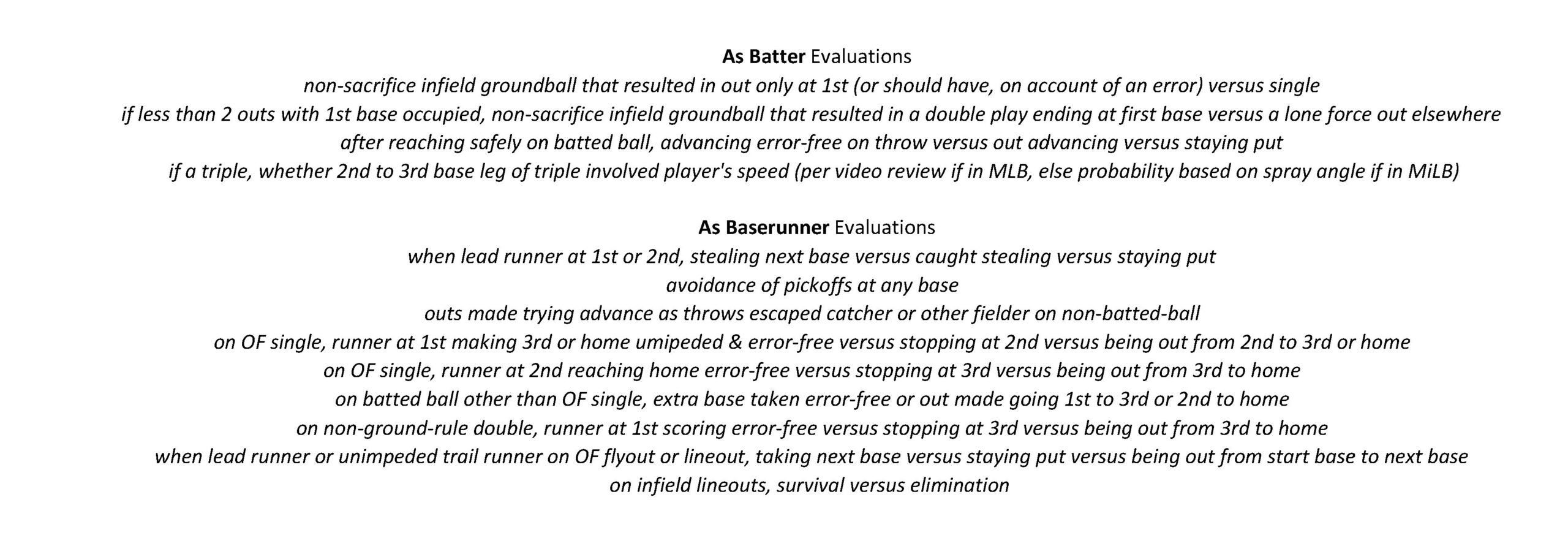
Prospect Analysis: Jacob Wilson
Evolution of College Plate Profile
Jacob Wilson played three NCAA Division 1 (D1) seasons at Grand Canyon University, a Western Athletic Conference baseball member that plays out of a semi-higher-elevation desert climate in Phoenix.
In between, he spent one wood bat summer in the Northwoods League and then a second one in the Cape Cod Baseball League (CCBL). The prevailing theme over those five campaigns was extreme strikeout avoidance. Wilson impressively rated in the 100th percentile at K Avoid as both a 2022 D1 sophomore and a 2023 D1 junior.
With the exception of the summer 2022 CCBL stint, Wilson seldom reached first via either the walk or hit-by-pitch route, as his BB+HBP Rating was more typically around minus (16). He was not the type of extreme contact hitter who would spoil pitches foul to lengthen plate appearances and increase the probability of reaching first without putting the ball in play.
Wilson posted an improved singles-promoting LD + IFFB Avoid + Pull GB Avoid trio within his batted ball profile during both spring and summer of 2022 before losing much of the LD + IFFB Avoid duo as a 2023 junior. Wilson was advanced at producing Pull-Third OFFB more often than OFFB in general on batted balls, which is good from the standpoint that he lacked the physical strength to produce much ISO damage on OFFB to center- or oppo-third.
More often than not, AVG and ISO on batted ball marks were middling in magnitude despite his playing in many hit-friendly venues. This also discouraged pitchers from nibbling around the strike zone and walking him more often.
Pre-draft scouting reports on Jacob Wilson at the plate referenced a seldom-walking double-to-triple plus strikeout avoider who had some aptitude for pulling outfield flyballs for extra bases but was not a particularly imposing hitter or slugger overall. In a relative surprise, the then-Oakland Athletics would select Wilson fifth overall in the 2023 MLB Draft, later signing him to a $5.5 million bonus that netted $1.1 million in bonus pool savings versus slot value for the pick.
Evolution of Pro Plate Profile
The first two pro seasons of 2023 and 2024 yielded plate profiles similar to those of the collegiate precedents. The loft on batted balls has been very low, with at least one OFFB and GB Avoid often in the single digits. Yet Wilson has continued to deliver pull-third OFFB per batted ball at a reasonably good clip, empowering him to still produce some ISO despite so few OFFB.
All MiLB AVG Ratings seen above fall in the range of 79 to 100, often so despite either a LD Rating or LD + IFFB Avoid + Pull GB Avoid trio that would explain such a high AVG mark. Some of that overproduction on batted balls relative to the fundamentals is likely owed to the Rookie League (AZ), Double-A (Midland, TX), and Triple-A (his past and future Las Vegas home) affiliates being situated in hitter-friendly environs not so unlike his collegiate place of baseball residence.
Such was not the case in the 102 MLB debut PA, as those sea-level-leaning plate trips begat only an 11 AVG Rating, which re-raised questions about how impactful of a hitter he could be in MLB.
Wilson apparently added some weight and strength in the offseason, though the exact pounds do not seem to have been updated on his MLB website bio. How did the plate profile look in MLB spring game action?
Spring OFFB and GB Avoid Ratings in the top row of the above table reveal that he lofted the baseball more than in the later part of the 2024 season. A reasonably good foursome of LD, Pull GB Avoid, Pull OFFB, and IFFB Avoid buoyed an almost plus 82 batted ball profile, though again (31) AVG and (49) ISO on batted balls were middling, though each represents improvement versus 2024 MLB debut marks.
Else, the same "exceptional K Avoid, low BB+HBP, pulls the relatively few OFFB well" bias from his draft day rings truer.
Evolution of Pro Offensive Running
Offensive Running Ratings are available on Jacob Wilson from 2023 MiLB, 2024 MiLB, and the 2024 MLB debut. As a frame of reference, Baseball Savant credited Wilson with 44th percentile raw sprint speed in 2024 MLB and with 43rd percentile sprint speed in 2025 MLB as of April 6.
But does he play relatively faster or slower than that based on the batter and baserunner events tracked by the Offensive Running Rating module?
Wilson achieved an 84 Offensive Running Rating over 114 team plate appearances that allowed for assessment of his running in the 2023 post-Draft MiLB debut. That plus mark sprang more from his registering faster as a batter (93) than as a baserunner (42). The same bias carried over to 100 team PA evaluated in 2024 AA, with a 91 as Batter mark but just a two as Baserunner mark.
For the full 2024 MiLB campaign, he rated below half minus (25) as an offensive runner. Same mark registered only minus (16) over 110 team event-relevant PA in the MLB debut, which included a hamstring injury three innings into it that likely further hamstrung his Offensive Running Ratings for what remained of the MiLB and MLB seasons.
We should project 2025 Jacob Wilson as a half to full minus offensive runner who affords relatively more non-negative value in that realm between the plate and first base as a batter than he does between the bases as a runner during plate appearances of others. As such, expect Wilson to play relatively slower as an offensive runner than circa 44th percentile raw sprint speeds.
Dynasty Fantasy Baseball Focus
Imagine Jacob Wilson as a right-handed-batting variation of Luis Arraez. Yet, as a righty and without a track record of consistently hitting line drives, Wilson should not post batting averages high enough to compete for league batting titles. Like Arraez, Wilson will not seize first much via either a walk or a hit by pitch and will seldom steal second after reaching first for lack of offensive running speed and/or baserunning prowess.
Wilson does have some sneaky pop owed to his skill at seizing on opportunities to produce a pull-third outfield ball. He likely tops out as a circa league-average power producer in peak seasons, though extra tiers of presently unknown home ballpark considerations must be weighed ahead as Wilson completes the organizational trek from Sacramento to Las Vegas over the next handful of seasons.
Just how well the underlying hitting fundamentals set up to enable him to hit for average and offset the limited contribution of walks plus hit by pitches to his on-base percentage is what to watch over his next season in the majors.
Wilson qualifies as a shortstop in fantasy leagues today, but will he still be in three to five years? Would future positional versatility more likely come via third base or second base?
Download Our Free News & Alerts Mobile App
Like what you see? Download our updated fantasy baseball app for iPhone and Android with 24x7 player news, injury alerts, sleepers, prospects & more. All free!

More Fantasy Baseball Advice

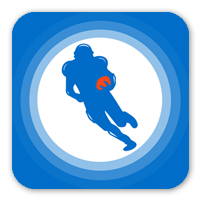



 RADIO
RADIO









